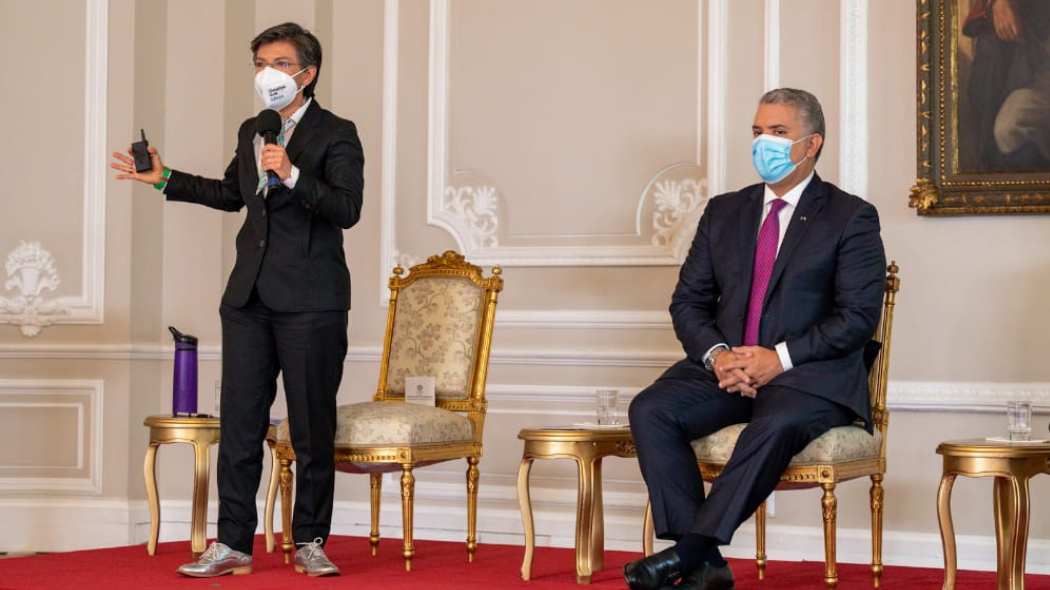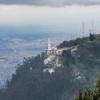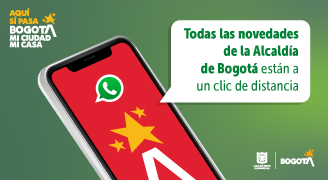Last week, the Mayor of Bogotá, Claudia López met with the Governor of Cundinamarca, Nicolás García and the President, Mr. Iván Duque to present the Bogotá Region Multimodal Mobility Network slated for 2035. This strategy includes strategic megaprojects, financed via CONPES, for public, local and regional transport:
- Line 2. Bogotá Metro (Suba - Engativá)
- Northern Regio-tram
- Route Expansion Ave. Ciudad de Cali (to Calle 80)
- Extension Line 1. Bogotá Metro (in the north of the city)
- Western border- Calle 13
Said projects must comply with the current requirements set by the National Government to have access to co-financing.
Other projects that are high on the list in the Bogotá Mobility Network Model are the San Rafael, San Cristóbal - Juan Rey, Ciudadela Sucre and Potosí - Sierra Morena overhead cables, the bike path El Porvenir and the Codito - La Calera road connection.
These mobility solutions will be accompanied by more infrastructure tailored to cyclists, as well as multi-modal interchange hubs and routes that link to the outskirts of the city.
“This is an especially happy day for Bogota and the wider region. The capital took nearly 60 years to have the first Metro line, now in a year and a half, with the help of the state and the Government of Cundinamarca, we set forth the multi-modal network with the added benefit of shared financing, clean and sustainable mobility,” explained Mayor López.
Likewise, it is expected that by 2027, Line 1 of the Bogotá Metro, the Western Regiotram, the Transmilenio System on Avenida 68 and Avenida Ciudad de Cali to Avenida de Las Américas will be ready; the expansion of the North Highway and Seventh Avenue; the Medio Milenio bike-path, and the Usaquén over-head cables in El Codito, the Reencuentro Monserrate and the San Cristóbal-Altamira line.
A very integral mechanism in any functional city is good public transport. Much like clean water and efficient waste disposal, public transportation is a commodity that affects the wider public. As things begin to re-open and people venture back to work or school, areas like the completion of road-works and public transport need to run smoother.
“In record time – working with great care and trust – Cundinamarca, Bogotá and the Nation, we have managed to accomplished this long-term vision for our transportation system. Building on the foundation that came before is the solution, transportation is not owned by the government, it is owned by and for the people,” Mayor Lopez went on to say.
Likewise, the idea of modern and environmentally responsible mass transport systems is in the best interest of the people and their quality of life, hence the importance of forging alliances that support the financing, structuring and implementation of projects aimed at improving mobility conditions in Bogotá and the wider metropolitan region.
The State has previously re-iterated its commitment to the Bogotá-Cundinamarca Region by endorsing its mobility strategies and has even co-financed specific projects such as Transmilenio (phases I, II and III), the extension of the NQS Transmilenio System to Soacha (phases I, II and III), the first line of Bogotá-section 1 (PLMB-T1), the Western Regiotram and the Transmilenio System on Avenida 68 and Avenida Ciudad de Cali.
“What we are presenting here today is not merely a vision but a reality. The only difference between a dream and a project is a deadline. Here we are fulfilling it. It is projects like this that will define a nation. Even in the midst of the pandemic, it hasn’t been easy carrying on with the most ambitious project of the highest investment value in the history of our capital, our Metropolitan Region, above all, our country.” Stated President Duque.
Mr. Duque went on to say that this is a CONPES "of more than 30 billion pesos and we are talking about the large cargo and passenger lanes that are going to improve the quality of life of this region’s inhabitants."
To this, Mayor Lopez applauded the joint efforts made between the state, local government and departmental government. “Your legacy, Mr. President, would be to leave the largest sustainable mobility network in Colombia’s history. This CONPES leaves investments mapped out in advance, prioritises projects, galvanises actions so that the Bogotá - Region has 222 kilometers of green, electric and sustainable mobility.”
In this regard, the Governor of Cundinamarca, Nicolás García, commented that “Work and projects that took more than a decade to be structured are manifesting in record time. We are leaving a real and concrete legacy that will transcend our time, and that will generate progress in our region." Mr. Garcia also agreed, among other things," to start moving towards that vision. in the long term, for that third Metro line to Soacha.”
“As of today, added Mayor López, “this is no longer a dream, it is no longer a slide on a power point presentation, it is a CONPES – that is to say – long-term public policy. This represents a commitment between the State, the Government of Cundinamarca and the Mayor's Office.” Meanwhile, the President was full of praise for the momentous occasion, “today, said President Duque, we begin constructing the Bogotá of the XXI century, which will be marked by clean, sustainable, quality mobility. Hopefully, the city, thanks to an in-depth vision of public transport, it is going to start removing the incentive for individual vehicles in the decades to come.”
Projects financed via CONPES
The Suba-Engativá Metro line
The new line, whose cost is estimated at approximately 13 billion pesos, will begin in Chapinero where it will connect with the PLMB-T1. From there, it will traverse the borough of Barrios Unidos, Engativá and Suba until it reaches the Fontanar del Río sector in the north-western corner of the city. This new line will keep its lock-up there as well, which in total will cover a span of 15.8 kilometers, of which the vast majority will be underground.
Along the route, 11 stations will be built, eight of them underground, the first five located on Calle 72 with: Carrera 11th, Avenida. NQS, Avenida. 68, Avenida Boyacá and Avenida. Ciudad de Cali. Then there will be three more stations on Avenida. Ciudad de Cali with: Calle 80, Calle 90 and Carrera 93rd. Stations 9 and 10 will be underground and will link up with streets 130A and 143A. Station 11 – the only elevated platform on this line – will be on Avenida Suba with Carrera 145A.
The commute between Fontanar del Río to Chapinero will be expected to take 22 minutes, and 44 minutes to get to the historic downtown. This means a decrease of 42% which is more or less a half hour in transit. This is a clear improvement on what was there before.
The Avenida Ciudad de Cali Extension
In addition to the development of the subway line to Suba and Engativá, the need to build on Avenida Ciudad de Cali between Calle 26 and Calle 80 is clear. This route will allow users from the towns of Engativá and Fontibón to link up with Metro Line 2, and will complement Avenida Ciudad de Cali, Route 1, between Avenida Las Américas and Avenida Circunvalar del Sur, which crosses the towns of Bosa and Kennedy, improving connectivity with the municipality of Soacha.
Along the 9.3 km, between Avenida Manuel Cepeda Vargas and Calle 80, a public space has been outlined that includes platforms 10 and 11 meters wide and a bicycle path. The corridor includes 2 mixed lanes and two lanes for mass transportation as well as 5 intersections, 1 operational connection and 12 stations.
The Northern Regiotram
With the development of this project, preliminarily called the Northern Regio-tram, a sustainable transportation option is provided that connects the neighbouring municipalities with Bogotá. Its route begins at km 5 of the current railway, near the Gran Estación shopping mall (26th street) in Bogotá, and runs north along Avenida. Novena until it reaches La Caro station. There it deviates to continue towards Chía, Cajicá and Zipaquirá, where it ends its run at km 53.
This route is under preliminary study but it has already reached a total of 47.5 km (24.9 km in the Capital and 22.6 km in the municipalities of La Sabana). Likewise, all options are being weighed to enable the operation of passenger trains and cargo lines, not to mention improve logistics optimisation between Bogotá and Zipaquirá.
The route is currently in the preliminary stages, comprehensive results are expected to arrive by the second quarter of 2022. From these studies, the operational and working model will be obtained, and the best alternative will be chosen from a technical, financial, environmental perspective.
The Western border- Calle 13
Calle 13 or Avenida. Centenario, is one of the main connecting routes between Bogotá and the western municipalities. Along with the ALO Centro project and the interconnector on Calle 80 – which includes the part of the West End circuit proposed by Bogotá – will connect with the roads of Cundinamarca. This will ease the burden of commuters by facilitating the transport of passengers and cargo and reducing jams and back-ups
It hasn’t been easy finding solutions for the traffic jams and delays that build up particularly in the west end of the city. Issues like this haven’t escaped the notice of the powers-that-be. Discussions have been tabled and an agreement has been made to unclog these jams by reinforcing the infrastructure in the west end. This deal seeks to amplify roads, re-prioritise key projects and improve connectivity between the western edge of the city and Cundinamarca. At the negotiation table was the National Infrastructure Agency (ANI) and the Infrastructure and Concessions of Cundinamarca (ICCU), on behalf of the State and the government of Cundinamarca respectively, and the city liaison in the form of IDU.
The benefits of this circuit will be evident by the improved accessibility, roads in excellent conditions for passengers and cargo, better urban crossings between Bogotá and the surrounding municipalities, greater modes of sustainable mobility and public transport, ample and friendly public spaces for pedestrians and cyclists. Not to mention, a far improved interaction with the western Regio-tram and better distribution of freight vehicle traffic entering and leaving the city.
The circuit in the west end will improve access and urban traffic between Bogotá and the surrounding municipalities for the benefit of 1,300,000 inhabitants, not least of which, the residents of Fontibón, Puente Aranda and Engativá. The construction of the circuit will actively contribute to the city’s economic re-activation, and by extension, the region. A fundamental benefit of this project is the impact it will have on the labour market, 80,000 new posts will need to be filled (51,112 in 13th street and 25,382 in downtown ALO).
In 2017, the IDU developed a case study and detailed designs of Calle 13 that includes an extension of 11.4 km from Carrera 50 to the western limit of Bogotá with Cundinamarca. Projects like this link up nicely with neighbouring municipalities like Fontibón and Puente Aranda. Of these, 10.7 km are on the main highroad and 0.7 km over the intersection of Carrera 50. In its route it has 6 intersections with important road thoroughfares that connect the city from north to south, 14 stations and a head station for inter-municipal transport.
The ALO Centro is a 6 km long project that will improve connectivity of Calle 13 with Calle 80 and with the south of the city. By giving continuity to projects like this we can ensure a better distribution of freight-traffic in and out of the city. It includes lanes of vehicular traffic, as well as pedestrian and bike paths along the route.
On Calle 80, a solution was put forward that will improve access to the city in this important sector, with two vehicular bridges that are linked with the current bridges that cross the Bogotá River, a roundabout at ground-level, and one connecting with the neighbourhood Lisboa that segregates vehicles upon leaving Bogotá.







